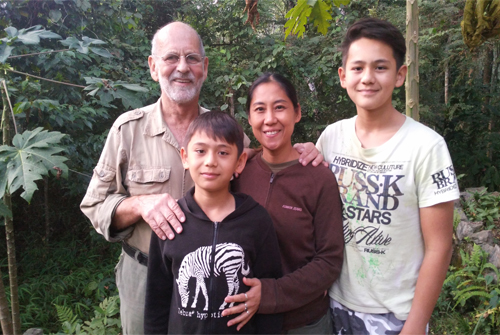All-Weather-Conservationist: Meet Tilo Nadler
Tilo was born and raised in Dresden, among wars, became a welder and an air-conditioning engineer before he struck a purple patch as field biologist. He travelled to Vietnam, Mongolia, Tibet, Antarctica, and São Tomé and Príncipe on expeditions before dropping anchor in Vietnam to establish the first wildlife rescue centre in Indochina now holding 15 of Vietnam’s 25 primate species. The Endangered Primates Rescue Centre (EPRC) has 6 critically endangered species including the Delacour's langur, Cat Ba langur and grey-shanked douc langur named on the World’s 25 most endangered primates list for years now. For seeing it all, especially global climate change impacts in his illustrious work, ACT honours Tilo Nadler as conservationist of the month – Ed.Pai
 |
|
Family Pix – from Left, Tilo, son Heinrich, Mrs. Hien Tilo and son Khiem. Photo credit: Murali Pai. |
Pai: Tilo, thank you for speaking to us. I am curious to know how you started with a hammer, became a birder and ended up as primate rehabber.
Tilo: I had to pick-up a hammer per force in DDR as biology was only for students from the working class families and my father Arthur was a locomotive engineer and the government said I had to study to be one too. But, I kept all kinds of critters at home including a pet raven and learnt ecology outside school. I did ornithological studies in Europe, Africa, Asia and Antarctica before primates in Vietnam became the purpose of my work.
Pai: That was an incredible journey. Who were your earliest influences who seeded your passion for biology?
Tilo: Even while growing up in Dresden, I was fascinated with tribes of the world and dreamt of going to South America for ethnographic research. Erich Wustmann inspired me in this field and tickets for his popular talks in Dresden would be sold out in no time. One day my dad and I arrived at the venue two hours before the event to buy tickets and found a man in front of the building. I asked, “Are you here for Wustmann’s talk?” and the stranger said, “I am Wustmann.” He took us both inside the venue and he is my hero ever since. I have learnt much from Heinrich Dathe, the long serving director of Berlin Zoo, who selected me for the Russian expedition to Antarctica, Gerhard Creutz the ornithologist who taught me banding birds. My interest in the primates of Vietnam was stoked by Jean Théodore Delacour, one of the greatest ornithologists of the last millennium. Delacour also discovered one of the beautiful primate species of Vietnam in 1930 and the Delacour’s langur features on the logo of the Centre (EPRC). I founded EPRC in 1993.
Pai: Tell us about the two years you spent in Antarctica and your take on climate change thereof?
Tilo: We were a team of 20 stationed in western Antarctica at the Soviet station Bellingshausen. We set sail in summer 1986 on the Baltic Sea from Rostock, and got to Uruguay in 4 weeks and then on to the Antarctica in a week. My brief as biologist was to conduct studies on population density, habitat use and growth rates of seals and torpor in birds. As for climate change, I could see for myself the decrease in extent and mass of the Antarctic ice sheets from the data analysed at the Bellingshausen. Also studies on the ice core studies clinch the evidence for increase in the greenhouse gases. The very purpose of field research in these stations is to document climate change alongside species level changes which may not be so obvious.
Pai: How about your work in Mongolia?
Tilo: I visited Mongolia 7 times in the late 70s and early 80s. The impacts of climate change are more discernible in montane and Polar Regions. I studied wetland birds like the lesser sand plover (Charadrius mongolus), which is a migratory species in Mongolia. I was excited to find nests of the plover only to discover they were of another plover species. But, I would never blame climate change for my mistake!
Pai: Please tell us about your expedition to São Tomé and Príncipe.
Tilo: It is an island paradise for birds and the avifauna count has risen to some 140 species now with one-fifth endemics including the critically endangered São Tomé fiscal (Lanius newtoni), and the grosbeak (Crithagra concolor). My sojourn there was for two months of field ornithology and many studies on climate change impacts on the island are now underway especially on soil conservation and agroforestry systems.
Pai: Now we come to the homestretch in Vietnam. How did you finally get here after all your travels?
Tilo: To begin with Vietnam was the only country I could travel with special permission as a citizen of DDR. I first went there as a nature lover, then filmed a documentary on the Delacour's langur, before I won a grant for capacity building of forest rangers. My foray into the rescue of endangered primates of Vietnam happened willy-nilly and it is testimony to the dedication of the project stakeholders mainly the government of Vietnam. The Cat Ba langur can be construed as a by-product of climate change because sea levels rise eons ago to restrict this beautiful species of 60 individuals to their unique limestone habitat of some 100 sq.km. They consume leaves of shrubs and berries growing on the karsts and are likely the only primate species that drink sea water. Presently I am focused on the reintroduction of rehabilitated primates to appropriate habitats in Vietnam.